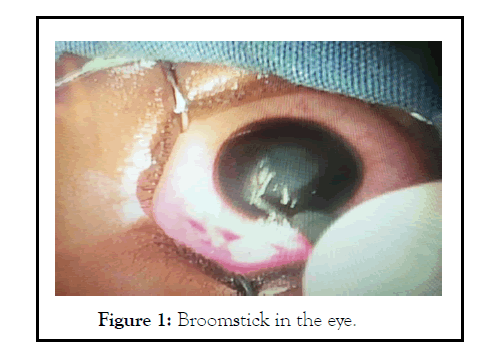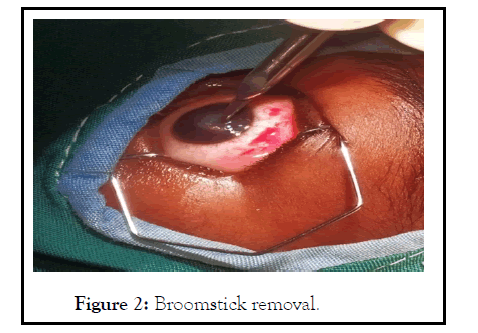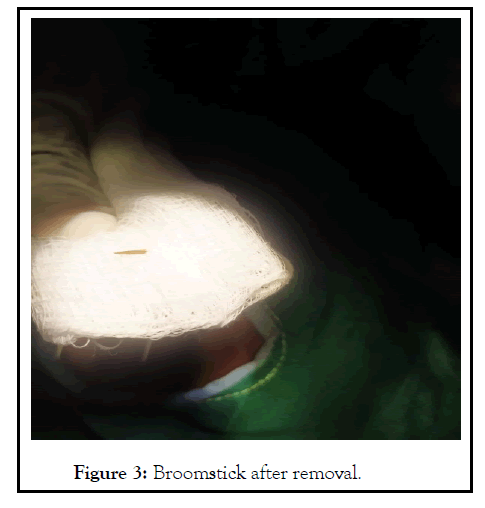Journal of Clinical and Experimental Ophthalmology
Open Access
ISSN: 2155-9570
ISSN: 2155-9570
Case Report - (2022)Volume 13, Issue 1
This is the report of a five year old Nigerian male child who presented at our eye center on April 06, 2021. The patient had left eye Grade 11 penetrating eye injury with retained broomstick. The patient had removal of the retained foreign body and corneal repair with 9/0 nylon the following day. The procedure was well tolerated and patient did well on topical non-steroidal anti-inflammatory drug, cycloplegic agent, topical and systemic antibiotics. In view of the traumatic cataract patient had, he was to have secondary surgical intervention when inflammation resolved fully. The need for children to be well supervised while exploring the environment in a bid to prevent ocular injury cannot be overemphasized. The fact that traditional eye medication was not applied coupled with prompt presentation and surgical intervention contributed to the successful outcome of management at the time of this report. Prompt presentation following ocular injury with or without retained foreign body most especially in children is recommended.
Broomstick injury; Male child; Nigeria; Cycloplegic agent, Corneal repair
Penetrating ocular injuries usually require prompt attention and management. In resource challenged environment as obtained in developing countries like Nigeria, the desire to be promptly attended to after sustaining penetrating eye injury may not be met due to one reason or the other. In about 40% of cases, penetrating eye injuries are complicated by the presence of intra ocular foreign body [1,2]. The foreign bodies may be toxic (iron, copper, vegetative matter) or non-toxic (glass or plastic). The pathway to loss of vision following penetrating eye injury with retained intra ocular foreign body may be from mechanical injury or post traumatic complications like endophthalmitis, retinal detachment, metal toxicity and sympathetic ophthalmitis [2]. Ocular trauma is an important cause of visual loss especially unilateral visual loss mostly in developing countries [3,4]. The socio-economic impact of penetrating eye injuries is huge most especially in developing countries like Nigeria in view of the fact that affected patients may need to be admitted and operated on [5] and this is coupled with the fact that health insurance scheme is not well established. Worldwide, 1.6 million people are blind from eye injuries 2.3 million people with bilateral low vision and 19 million cases of monocular blindness [4]. Eye injury remains one of the notable causes of visual loss in pediatric population. In view of the inability of children to avoid hazards, they are more prone to ocular injuries. Male children are known to be more aggressive and adventurous than females thus they are more prone to eye injuries [6]. Our index case in this report is a 5 year old male. Thus this presentation is supported by the preceding statement.
The patient is a 5 year old school boy who was referred to our clinic on April 06, 2021, on account of injury sustained to the left eye by a broomstick while playing with his friends at home a day earlier. There was no history of use traditional eye medication. At presentation, the visual acuity was HM on the injured eye and 6/5 on the right, there was fair eye opening with periorbital edema and upper lid edema. There was watery eye discharge with associated hyperemic conjunctiva (Figures 1 and 2). There was corneal laceration around 8 o’clock with a foreign body (a piece of broom stick) measuring about 8 mm (Figure 3) protruding from the cornea. The anterior chamber was still of fair depth and greater portion of the broomstick was in it. The pupil was irregular. The lens was opaque and there was no further view. The anterior and posterior segments of the right eye were normal. An assessment of Left Eye (LE): Grade II penetrating ocular injury with retained broomstick was made. Immediate decision was made for surgical intervention (viz. LE: foreign body removal and corneal laceration repair) the following day. After a negative COVID-19 screening test result a left eye intracameral foreign body removal with corneal laceration repair was done with 9/0 nylon on April 07, 2021. Surgery was well tolerated and immediate post-op. condition was satisfactory.

Figure 1: Broomstick in the eye.

Figure 2: Broomstick removal.

Figure 3: Broomstick after removal.
Examination on first day post-op (April 08, 2021) revealed a fair eye opening with mild lid edema. The visual acuity in the operated eye was HM. Wound site was intact with stromal corneal edema. Anterior chamber was slightly shallow. Pupil was irregular and lens was opaque (cataract).
Patient was placed on the following post-op medications:
• Gutt. Atropine 1% BD (LE)
• Gutt. Moxifloxacin hourly (LE)
• Gutt. Tobramycin hourly (LE)
• Gutt. Flucamed QID (LE)
• Syrup. Augmentin 275 mg (15 ml) TDs × 1/52
• Syrup. PCM 5 mls BD × 4/7
• Syrup. Vitamin C 10 mls TDs × 1/52
Patient’s parents were counselled on the prognosis of the surgery and the need for a secondary intervention later was expressed. Ocular ultrasound done 12 weeks post-op. Was suggestive of traumatic cataract and vitreous chamber echogenic mass. The patient was scheduled for further surgical intervention when inflammation fully resolved.
The early presentation of the patient is commendable in view of the fact that the patient was referred to our center from another locality. This may have to do with age of the child, the fact that parents were well motivated and the promptness of the referring medical personnel in initiating the referral. The offending agent was a vegetative matter (broomstick) and this explains why the patient was offered surgical intervention promptly in a bid to prevent infection (most especially endophthalmitis) and sympathetic ophthalmitis. In view of these stated facts, penetrating eye injuries particularly if there is a retained foreign body requires urgent surgical intervention. The use of traditional eye medication still remains a challenge in this part of the world, however it is worthy of note that traditional eye medication was not applied on the injured eye prior to presentation and afterwards. This probably contributed to the relatively successful outcome of the surgical intervention. Children tend to engage in outdoor activities in this part of the world as some of the children don’t have toys to play with and thus they tend to explore the environment for recreation. Thus materials that are readily available in the environment like stones and pieces of wood are used in playing by children [7]. Some children without adequate supervision are allowed to carry out activities like wood chopping that should ordinarily should be carried out by adults in view of the risks posed to their eyes by some of these activities [7]. The case reported sustained the ocular injury while playing at home and this may be a pointer to the low level of awareness on the dangers inherent in some of the materials children play with at home. In a previous report in Port Harcourt, Nigeria, two cases of broomstick eye injury were seen [8].
In another study carried out in Benin City, Nigeria, twenty cases of broomstick injuries were reported between January 2003 and June 2014 [9]. All the patients in the latter study were children less than 14 years of age with male: female ratio of 3:1 [9]. Brooms are commonly used for house hold chores like sweeping and are usually very dirty in view of what they are used for. They therefore tend to cause highly infected injuries. This fact explains why the patient was placed on both topical and systemic antibiotics to manage the infection.
The case highlighted brings to fore the need to create awareness on the dangers posed to the eyes of children by some of the materials they play with in the environment. The danger of injury from traditional broomsticks in particular should be highlighted during health education. The use of plastic brooms as alternative to traditional brooms should be suggested to households. The need for prompt referral and treatment at the appropriate eye center in cases of injury to the eyes especially with retained foreign body like broomstick cannot be over emphasized.
[Crossref] [Google Scholar] [Pubmed]
[Crossref] [Google Scholar] [Pubmed]
[Crossref] [Google Scholar] [Pubmed]
[Crossref] [Google Scholar] [Pubmed]
[Crossref] [Google Scholar] [Pubmed]
[Crossref] [Google Scholar] [Pubmed]
[Crossref] [Google Scholar] [Pubmed]
[Crossref] [Google Scholar] [Pubmed]
[Crossref] [Google Scholar] [Pubmed]
Citation: Omolase CO, OT Ogunleye, Sotiloye OA, Oduegwu AJ, Omolase BO, Egberongbe AA (2021) Penetrating Ocular Injury with Retained Broomstick in a Nigerian Male Child. J Clin Exp Ophthalmol. 13:906.
Received: 17-Dec-2021 Editor assigned: 20-Dec-2021, Pre QC No. JCEO-21-14018 (PQ); Reviewed: 03-Jan-2022, QC No. CEO-21-14018; Revised: 10-Jan-2022, Manuscript No. JCEO-21-14018 (R); Published: 17-Jan-2022 , DOI: 10.35248/2155-9570.22.13.906
Copyright: © 2022 Oluwole OC, et al. This is an open-access article distributed under the terms of the Creative Commons Attribution License, which permits unrestricted use, distribution, and reproduction in any medium, provided the original author and source are credited.